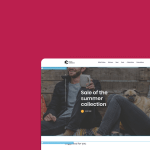So you’ve decided that you want to take your e-commerce architecture headless and are starting to look at the headless frontend options out there? Before getting too swept up in the excitement of discovering new tech, you first need to ask yourself a few questions. This will allow you to know exactly what you’re looking for, what your non-negotiables are, and where you have a little more flexibility.
We’ve compiled 10 questions we believe you must be considering if you’re looking for a new headless frontend. These include both questions you need to ask yourself about your business needs and things you need to look out for in the providers you’re considering.
Let’s dive in.
You’re not actually sure about headless yet?
Check out our guide to understand whether it’s right for you.
Find out more here or fill out the form ⬇️
1. What are my specific business goals and objectives for the next 1-3 years, and how must my choice of a headless frontend align with these goals?
This initial question serves as the foundation for the entire decision-making process. By identifying and clarifying these goals, an e-commerce retailer can effectively evaluate how a headless frontend aligns with their strategic vision. For instance, if the goal is to expand into new markets or launch innovative features, the chosen headless solution should offer scalability, flexibility, and support multi-country websites to accommodate these ambitions. Conversely, if the focus is on enhancing the user experience or streamlining internal operations, the headless frontend must provide features and integrations that directly contribute to achieving these objectives. This question ensures that the selection process is not only technically sound but also intricately tied to the overarching business strategy, fostering a coherent and purposeful digital commerce roadmap.
2. Who is my target audience, and what kind of user experience do I want to provide to enhance their shopping journey?
Recognizing the target audience is crucial for tailoring the headless frontend to meet their specific needs and preferences. Whether the audience is tech-savvy millennials, luxury goods buyers with high expectations, or a diverse demographic, the chosen frontend should align with their expectations. The headless architecture, when aligned with the characteristics and behaviors of the target audience, can offer the necessary tools and features to enhance the overall online shopping experience. This question prompts e-commerce retailers to envision their customer’s journey, ensuring that the headless frontend becomes a strategic enabler for delivering a compelling and user-centric digital storefront.
3. What level of scalability and flexibility does my e-commerce platform require, and how can a headless frontend solution accommodate these needs?
By recognizing the potential for growth and adaptation over time, retailers can evaluate the scalability needs of their business. A headless frontend offers a distinct advantage here, providing a modular and flexible architecture that allows for seamless scalability. By decoupling the frontend from the backend, it enables e-commerce platforms to scale more efficiently to meet increasing demands, whether it’s a surge in traffic, the addition of new products, or expanding into new markets. You must ensure that potential providers can offer the scaling capabilities and connectivity options, generally through APIs, that are needed to future-proof your e-commerce.
4. What are your long-term expectations for the frontend provider? Do you want access to long-term updates and improvements or would you rather a fixed setup that is not set to evolve in the coming years?
When selecting a headless frontend provider, it’s crucial to consider your long-term expectations for the solution. Do you envision your e-commerce platform undergoing significant changes and requiring regular updates? Do you want access to the latest features and advancements in headless frontend technology? If so, prioritize providers that offer long-term support, regular updates, and a commitment to continuous improvement. At Front-Commerce, we fall under this category, providing our customers with access to all our latest versions, integrations and updates, to do with whatever they see fit. Alternatively, if your e-commerce platform is relatively stable and you prioritize stability over constant evolution, consider a provider that offers a fixed setup.

Dive a little deeper into the portability and longevity of Front-Commerce storefronts
5. How important is mobile responsiveness for my business?
According to a study by Statista, mobile e-commerce sales reached $2.2 trillion in 2023, now making up 60% of all e-commerce sales around the world. So you can’t overlook the importance of mobile commerce. Ensure your potential providers offer a responsive and PWA-enabled frontend.
6. What integration capabilities are essential for my e-commerce ecosystem, such as CRM, inventory management, and payment gateways? And is the provider’s technology stack compatible with your current technology stack?
A robust e-commerce ecosystem relies on seamless integration between various systems, including CRM, inventory management, and payment gateways. To ensure a smooth and efficient shopping experience, your headless frontend solution should seamlessly integrate with these systems. Evaluate the integration capabilities of different headless frontend providers to ensure they can effectively connect with your existing technology stack. This includes checking for compatibility with your CRM provider’s APIs, inventory management software, and payment gateway infrastructure.
7. What is my budget for the implementation, maintenance, and ongoing support of the headless frontend?
As you begin your search for a headless frontend solution, it’s essential to establish a realistic budget that encompasses the initial implementation costs, ongoing maintenance expenses, and any additional support fees. Consider the pricing models offered by different providers, which may include upfront license fees, monthly or annual subscriptions, and usage-based pricing. Factor in the cost of training, onboarding, and any specialized consulting services you may require. Remember that support is crucial for ensuring the smooth operation and timely resolution of any issues that may arise. Don’t underestimate the value of comprehensive support and factor in the ongoing costs associated with it.
Some providers, like Front-Commerce, will include long term training & support as well as code reviews in their pricing packages.
8. What is the learning curve associated with the implementation of the selected headless frontend for your developers ?
Assess the complexity of the provider’s documentation, tutorials, and training resources. Determine if your developers possess the necessary skills and experience to efficiently implement and maintain the headless frontend solution. If extensive training or onboarding is required, factor in the additional time and resources needed to bring your team up to speed.
At Front-Commerce, we’ve adopted React, Node, GraphQL, and the Web Platform and have always tried to build on top of them with the best practices in mind. As such, developing with Front-Commerce feels like working with these technologies outside of Front-Commerce. This allows developers to quickly be efficient on Front-Commerce projects.

Developers love Front-Commerce – here’s why!
9. How does the headless frontend impact website loading times and overall performance?
Website speed is a critical factor influencing user experience and search engine rankings. This question urges e-commerce retailers to evaluate how the chosen headless architecture enhances or potentially hampers website loading times and overall performance. A well-optimized headless frontend should offer benefits such as faster page loads, efficient content delivery, and improved user interactions. By considering the performance implications, retailers can ensure that the selected headless solution aligns with their expectations for a fast, responsive, and high-performing online store, contributing positively to user satisfaction and business success.
10. How robust is the support and documentation provided by the headless frontend provider, and what is the availability of technical assistance or customer support when needed?
Comprehensive and well-structured documentation is essential for developers to understand the headless frontend architecture, API functionalities, and best practices for implementation and maintenance. Additionally, readily available technical assistance or customer support is critical for promptly addressing any technical challenges or questions that may arise during development or deployment. Look for providers that offer multiple support channels, such as online forums, live chat, and email support, to ensure that your developers have access to timely and helpful assistance when needed. A well-supported headless frontend solution can significantly reduce development time, mitigate potential issues, and ensure the long-term success of your e-commerce platform.
Selecting the right headless frontend solution requires careful consideration of your e-commerce business needs, technical capabilities, and long-term goals. By thoroughly evaluating each provider’s features, integration capabilities, support offerings, and pricing models, you can make an informed decision that aligns with your specific requirements and sets your e-commerce platform on a path to success. Remember that a headless frontend should not only enhance your storefront’s design and flexibility but also seamlessly integrate with your existing technology stack, optimize website performance, and empower your developers to create a truly exceptional customer experience.
